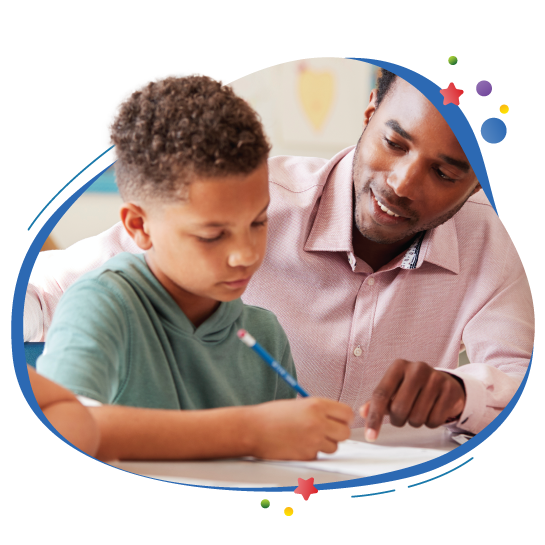My Account Details
Research Foundations

From Humble Beginnings
to Classrooms Worldwide
SRA Reading Laboratory® was created in 1950 by Don H. Parker, Ph.D., who developed the program while teaching in a rural Florida classroom. Faced with the challenge of reaching different learners, Parker devised a method of color-coded reading levels, so students could begin reading at an appropriate level and work upward through increasingly challenging content.
What began as a simple system housed by a tomato box has evolved over time to include engaging, contemporary literature; new technology; and a host of other components that enhance the program’s proven format while retaining its simplicity. SRA Reading Laboratory is an essential instructional tool for teachers around the world.

Supporting Research
In December of 2000, with support from the National Institute of Child Health and Human Development, the National Reading Panel published a meta-analysis of existing research to determine the most effective strategies for building literacy (NIH Pub. No.00-4754). Their findings fully support the foundational concepts and instructional design of SRA Reading Laboratory.
This report includes research documentation that supports the comprehension skills and strategies found in SRA Reading Laboratory. Examples of cited research include:
Collins, C. (1991). Reading instruction that increases thinking abilities. Journal of Reading, 34(7), 510-516.
Pressley, M., El-dinary, P.B., Gaskins, I., Schuder, T., Bergman, J., Almasi, J., & Brown, R. (1992). Beyond direct explanation: Transactional instruction of reading comprehension strategies. Elementary School Journal, 92(5), 513-555.
Rosenshine, B., & Meister, C. (1997). Cognitive strategy instruction in reading. In S. Stahl & D. Hayes (Eds.), Instructional models in reading. (pp.85-107). Mahwah, NJ: Lawrence Erlbaum Associates.
This report includes research documentation that supports the phonics skills and strategies found in SRA Reading Laboratory. Examples of cited research include:
Adams, M.J. (1990). Beginning to read: Thinking and learning about print. Cambridge, MA: MIT Press.
Chall, J. (1996a). Learning to read: The great debate (revised, with a new foreword). New York: McGraw-Hill.
Ehri, L.C. (1998). Grapheme-phoneme knowledge is essential for learning to read words in English. In J.L. Metsala & L.C. Ehri (Eds.), Word recognition in beginning literacy. (pp. 3-40). Mahwah, NJ: Erlbaum
This report includes research documentation that supports the vocabulary skills and instructional practices found in SRA Reading Laboratory. Examples of cited research include: but are not limited to, the following:
Beck, I.L., Perfetti, C.A., & McKeown, M.G. (1982). Effects of long-term vocabulary instruction on lexical access and reading comprehension. Journal of Educational Psychology, 74(4), 506-521.
Gipe, J.P., & Arnold, R.D. (1979). Teaching vocabulary through familiar associations and contexts. Journal of Reading Behavior, 11(3), 281-285.
Kameenui, E., Carnine, D., & Freschi, R. (1982). Effects of text construction and instructional procedures for teaching word meanings on comprehension and recall. Reading Research Quarterly, 17(3), 367-388.
McKeown, M.G., Beck, I.L., Omanson, R.C., & Pople, M.T. (1985). Some effects of the nature and frequency of vocabulary instruction on the knowledge and use of words. Reading Research Quarterly, 20(5), 522-535.
This report includes research documentation that supports the fluency instruction and practices found in the in SRA Reading Laboratory. Examples of cited research include: but are not limited to, the following:
Biemiller, A. (1977-78). Relationships between oral reading rates for letters, words, and simple text in the development of reading achievement. Reading Research Quarterly, 13, 223-253.
Pinnell, G.S., Pikulski, J.J., Wixson, K.K., Campbell, J.R., Gough, P.B., & Beatty, A.S. (1995). Listening to children read aloud. Washington, DC: Office of Educational Research and Improvement, U.S. Department of Education.
Strecker, S., Roser, N., & Martinez, M. (1998). Toward understanding oral reading fluency. In T. Shanahan & F. Rodriguez-Brown (Eds.) Forty-seventh Yearbook of the National Reading Conference. (pp. 295-310). Chicago, IL: The National Reading Conference.
Wagner, R., Torgesen, J. & Rashotte, C. (1999). Comprehensive test of phonological processes. Austin, TX: Pro-Ed.